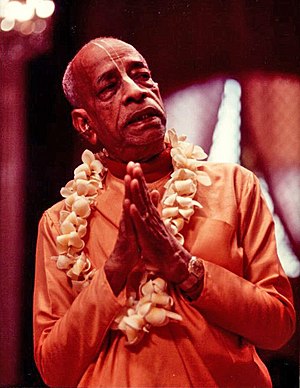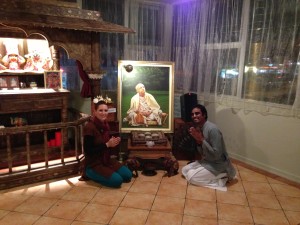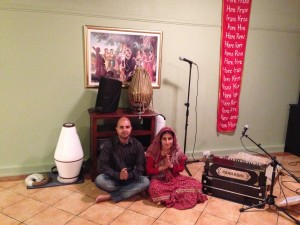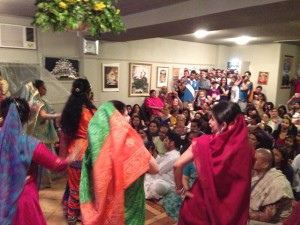
First, I would like to honor His Holiness Hrdayananda Dasa Goswami for his jolly disposition and his determination to assist his glorious master to his very best ability – which is considerably better than my own. Since he has encouraged and helped me in the past, I will attempt to reciprocate in a humble way – as a child might help his parents, or as we can worship the sun with a small lamp, or the Ganges with a bit of her own water.
Several sources published a “Q&A with Srila Acharyadeva on Raganuga Bhakti” in which Mahārāja brings up Aindra dāsa. The question to which Mahārāja will reply begins thus:
It is mentioned in Jaiva Dharma that without practicing raganuga bhakti (which specifically refers to following the vrajavasis in our siddha deha and not sadhaka deha) one cannot go back to Krsnaloka or Goloka Vrindavan but one can go to Dwaraka.
The parenthetical statement here – “(which specifically refers to following the vrajavasis in our siddha deha and not sadhaka deha)” – expresses a completely flawed understanding of what rāgānugā-sādhana actually is. The correct understanding, given from very early in ISKCON history by our founder acarya A.C. Bhaktivedanta Swami Prabhupada in Nectar of Devotion, is expressed originally by Sri Rupa Goswami’s Sanskrit definition of how to practice rāgānugā:
seva sadhaka rūpena siddha rūpena cātra hi
In Rāgānugā Sādhana, service (seva) certainly (hi) takes place simultaneously in both (ca) the devotee’s internal (siddha-rupena) and external (sadhaka-rupena) form/identity.
In simpler words, the devotee’s external deeds are infused with internal relevance, as a result of the devotee having a deep, internal sense of what those external deeds represent. The dichotomy between the siddha and sādhaka deha expressed by the person asking Mahārāja this question, does not reflect that actual definition of rāgānugā-sādhana. It is a misconception on the part of the questioner.
The rest of the question and answer is based on the misconception that there is a dichotomy between internal and external practices, between preaching and practice. This is certainly neither the philosophy of Sri Rupa, nor any of his representatives, especially Srila Prabhupada and his disciple Aindra Prabhu. The entire main thrust of Aindra Prabhu’s book, for example, is to make this very point that there must be no dichotomy between deep practice and effective preaching.
Instead of correcting the fundamental flaw in the question, HDG answered the question as if it were valid. It was hopefully just an oversight on his part, as we tend to believe he must be aware of these essential, foundational definitions. If this error on the part of the questioner were corrected, there would have been no need for Mahārāja to say anything else. Nevertheless, he did say other things – and we would beg your kind attention as we discuss them.
1. Srila Prabhupada states many times that his faithful disciples who assist his mission will go back to Vrindavana.
The context of this otherwise beautiful statement is that it is stated in opposition to the idea that one must practice rāgānugā-sādhana to be able to enter transcendental Vṛndāvana.
On one hand, Śrīla Prabhupāda made the statements Mahārāja mentions above. On the other hand it is clearly stated by Visvanatha Cakravarti (for example in Madhurya Kadambini), Bhaktivinode Thakur (for example, in Jaiva Dharma) and Srila Prabhupada himself (for example in Krishna Book and Nectar of Devotion) that the only path to Vrndavana is to follow the spontaneous, unbounded loving sentiments of an eternal resident of Vrndavana. This, however, is only an apparent contradiction, which is not very difficult to resolve.
Those disciples who “faithfully assist his mission” will faithfully understand his instructions as to the importance of practicing their devotional service in deep cognizance of its spiritual significance and relevance to developing an intimate relationship with Śrī Krishna (a.k.a. the “r” word: rāgānugā-sādhana). Such faithful disciples who assist his mission in that faithful mood will thus attain Sri Vrndavana’s Krishna Lila. It is not that by sweeping the temple or balancing the books but not chanting with the mood of pure love that one can “faithfully assist the movement” to a degree that warrants full reward. Partial assistance warrants partial rewards. People whose faith in and comprehension of Śrīla Prabhupāda’s mission remains partial will also receive benefit: eventually they will comprehend the essential importance of raganuga sadhana in the active preaching movement and will practice accordingly. THEN they will have fully faithfully, fully assisted the full movement of Srila Prabhupada, and will get the full reward: Krishna in Vrndavana.
2. In fact, those who devote themselves to Prabhupada’s service, and seriously practice bhakti-yoga, are coming to the stage of raganuga-bhakti.
I fully agree that Raganuga Sadhana and the service of Srila Prabhupada’s mission are identical, and certainly not mutually contradictory by any stretch of the imagination.
3. Preaching itself is raganuga-bhakti, not an inferior activity as some foolishly think.
I fully agree and would like to remind or perhaps inform HDG that this is in fact the main theme Aindra Prabhu believed in and attempted to communicate in his book.
4. The Bhagavatam does not explicitly state that we must practice a separate Raga-bhakti.
As established at the beginning, rāgānugā-sādhana is not a “separate practice.” Thus, the statement that Bhagavatam does not recommend it “as a separate practice” is highly misleading.
The Bhagavatam is cent-percent a book of rasa from start to finish, promoting the love of the vrajavasis for Krishna as the highest spiritual ideal, and constantly advising, inspiring and instructing us to cultivate a similar service mood by constant Samkirtan – hearing and chanting about Krishna and the loving services the vrajavasis share with him. This is the sum and substance of the Bhagavatam as well as the sum and substance of Raganuga sadhana – thus the two Bhagavatam and Raganuga sadhana are inseparable (as made crystal clear in the logo Srila Bhaktisiddhanta Saraswati instituted for the Gaudiya Math, for example).
In short, the Bhagavatam is the sourcebook for the depth of conception required of a genuine rāgānugā-sādhaka. That is its entire reason for existing.
Based on this misleading statement that “the Bhāgavatam does not explicitly state that we must practice a separate Raga-bhakti,” Mahārāja goes on to imply that Śrī Caitanya Mahāprabhu is satisfied with vaidhi-sādhana. I don’t want to directly argue with the Swāmī, whom I sincerely respect, but I cannot erase my knowledge of Kṛṣṇadāsa Kavirāja’s well-known declaration of the very purpose and essential motive behind the avatāra of Śrī Caitanya Mahāprabhu [recorded in the beginning of the third chapter of Caitanya Caritāmṛta's Ādi-līlā]:
sakala jagate more kare vidhi-bhakti
vidhi-bhaktye vraja-bhāva pāite nāhi śakti
“Everywhere in the world people worship Me according to scriptural injunctions [vidhi-bhakti]. But simply by following such regulative principles [vidhi-bhakti] one cannot attain the loving sentiments of the devotees in Vrajabhūmi.
aiśvarya-jñānete saba jagat miśrita
aiśvarya-śithila-preme nāhi mora prīta
“Knowing My opulences, the whole world looks upon Me with awe and veneration. But devotion made feeble by such reverence does not attract Me.
aiśvarya-jñāne vidhi-bhajana kariyā
vaikuṇṭhake yāya catur-vidha mukti pāñā
“By performing such regulated devotional service in awe and veneration [vidhi-bhajana], one may go to Vaikuṇṭha and attain the four kinds of liberation.
yuga-dharma pravartāimu nāma-sańkīrtana
cāri bhāva-bhakti diyā nācāmu bhuvana
“I shall personally inaugurate the religion of the age — nāma-sańkīrtana, the congregational chanting of the holy name. I shall make the world dance in ecstasy, realizing the four mellows of loving devotional service.
Please note, that Krishna himself became Mahāprabhu because he felt that vaidhi-bhakti was insufficient. It does not bring souls to the intimate type of affection that he desires to enjoy; it does not lead to vraja-bhūmi – it is comparatively “feeble” – thus it can only lead to the four types of liberation available in Vaikuṇṭha, it cannot lead to the four mellows of loving devotional service relished only in vraja-bhūmi.
It is very important to carefully hear exactly what Mahāprabhu / Krishna intended to be the main heart and soul of rāgānugā-sādhana. The heart and soul of genuine rāgānugā-sādhana is “nāma-sańkīrtana, the congregational chanting of the holy name.” I think Hṛdayānanda dāsa Goswāmī will appreciate this – because I feel the he expressed an intuitive and realized understanding that real rāgānugā-sādhana is not “separate” or “fundamentally different” from the heart and soul of Śrīla Prabhupāda’s ISKCON: ”nāma-sańkīrtana, the congregational chanting of the holy name.”
5. …Are we really to believe that Krishna will deny His Vraja-dhama to those who give their lives to His pure devotee, Prabhupada?
We have to “believe” all the statements of of śāstra and reconcile them all into a non-dual realization. We have to believe Kṛṣṇadās Kavirāja, for example, quoting Krishna as saying that “Vaidhi-bhakti only leads to Vaikuṇṭha, not Vṛndāvana.” Therefore we have to understand that “giving our lives to Krishna’s pure devotee” is more than an external checklist of activities, and mannerisms. The most essential part of giving our life to Śrīla Prabhupāda is to perform nāma-saṁkīrtana as the heart and soul of rāgānugā-sādhana - the potent entity that will influse our external activities and mannerisms and duties with the spiritual relevance of an intimate connection to Śrī Krishna.
The intimate corners of Vraja dhama are denied even to Brahma, Shiva and Narada, what to speak of us. We have the credit that Śrīla Prabhupāda is our guru. But Brahmā, Śiva and Nārada also have similar credits. So if Vraja will be denied to them, shall we protest that it be denied to our dirty and puny selves? Vraja prema is the rarest commodity in existence (sudurlabha) because it controls Krishna (Sri Krishna karshini), therefore it is only given to a very rare few. Simply signing up for an organization and following its external morays will not convince Krishna to give us the keys to his most private abode, Sri Vrndavana.
I don’t mean to imply that “signing up” for ISKCON and going through the external checklists of membership is entirely irrelevant. It is quite relevant. This external adherence can purify us so that at some future point, in this life or the next, we can comprehend what rāgānugā sādhana really is, and understand the preaching mission more deeply – recognizing the inseparable nature of deep practice and deep preaching. Then, by serving the preaching mission in the true “rāgānugā-preaching-mārga” of the nāma-saṁkīrtana movement, we can hope to qualify to beg for the mercy that opens the gateways even to the outermost edges of Sri Vrndavana Dhama.
6. Aindra Prabhu did great service. He also wrote a book in which he seems to insult all the preachers of the world and place himself above them as their teacher.
Since Hṛdayānanda dāsa Goswāmī appears not to know that the primary theme of Aindra’s book is the inter-supportiveness of preaching and practice, we doubt that he actually read the book very seriously. Thus we would advise him not to critique its content. In a way, we cannot slight Mahārāja for not being able to get to the essence of Aindra’s book. It is a difficult book to read, we admit – full of unbridled passionate ferocity. Therefore, by the grace of the vaiṣṇavas, we will soon present “A Book About Aindra’s Book.” Also, we will soon be releasing an official biography of Aindra Prabhu which will set the passionate and colorful figure in good context. We invite and humbly beg ISKCON’s leaders and influential persons, such as HDG, to be merciful unto us by enjoying these forthcoming books thoroughly, despite their dauntingly dense devotional schedules.
I never heard an Aindra kirtana in which he first chanted the pranama prayers to his guru, Prabhupada. It is unusual to never begin kirtan by thanking and honoring your own guru, who happens to be a nitya-siddha devotee.
This seems to imply that Aindra Prabhu disregards Srila Prabhupada, an insinuation that could not be more painful to hear, nor any further from the truth.
Mostly, one hears Aindra perform akhanda kirtan (“unbroken / 24-hour kirtan”) - in which it is a requirement that the mahā mantra not be mixed with any other mantras. Before every kīrtan, however, Aindra prabhu, and any member of the 24-hour Kirtan Mandal following Aindra’s express instructions, would pay obeisances before Srila Prabhupada’s vyasasana, chanting the “nama oṁ…” mantra, then pay obeisances to Gaura-Nitai chanting the “jaya śrī-kṛṣṇa caitanya…” mantra, then pay obeisances to Krishna-Balarāma and Rādhā-Śyāma before paying obeisances to the kīrtana-mandap, and only then sit down to perform kīrtan.
Also, do to the extreme devotion for Srila Prabhupada and Sri Sri Gaura Nitai in Aindra’s heart, he developed realizations of how the Hare Krishna mahāmantra does not exclude them from it’s meaning. He stated several times that at least half of the time he was chanting in this mood, rather than directly chanting the more obvious meanings of the mantra - wherein it directly refers to Rādhā Śyāmasundara.
Whenever Aindra would lead other kirtan, not akanda-kīrtan, for example mangala-arati, he would begin with “nama om…”
7. I suggest you read the Bhagavatam 6.17.28, which states that those actually devoted to the Lord do not worry about where they are going. They simply want to serve Krishna and they know that Krishna will reciprocate with their desire.
8. The essence of Vrindavana is selfless service, not trying to relish Krishna Lila. The essence of Vraja is forgetting any personal desire, including the desire to relish bliss, and rather doing whatever will please Krishna.
We agree entirely. There is not a soul in all of Vaikuntha who has any significant self-interest, and there is certainly not a single soul in Vṛndāvana who has any scent of a trace of any self-interest. The reason for desiring Vrndavana is not for personal happiness, but because Krishna desires Vrajavasis. He is addicted to their superpowerful love.
With the desire to give Krishna what he wants most, we earnestly desire to desire genuine Vrndavana Bhakti.
I pray that Hṛdayānanda dāsa Goswāmī will look affectionately on my attempt to clarify these points, and that the gentle readers will be kind also with their evaluation of my meanings and my motives. If the dust from the feet of the followers of Hṛdayānanda dāsa Goswāmī, a dear associate of Śrīla Prabhupāda, should fall upon my head, it would be more of an honor than wearing Indra’s crown, …or even Rukminī’s.
Written on behalf of our dearest friend, Aindra Dasa
By an insignificant and unworthy servant,
Vraja Kishor Das Peapod


 Dallas Morning News,
Dallas Morning News,



 The vivaha-samskara (wedding rite) offers an excellent opportunity to spiritualize thoughts, emotions, and commitments that accompany being united with one's chosen partner. A Vaishnava wedding (a wedding of devotees of Krishna) is not only a colorful, joyful ceremony but also a source of devotional inspiration for years to come. When difficulties arise in the relationship, we may ask ourselves, "How did I get into this situation? Why did I marry this person?" Then the mind will go back to the wedding day and automatically remember Lord Krishna, His devotees, and His loving service.
The vivaha-samskara (wedding rite) offers an excellent opportunity to spiritualize thoughts, emotions, and commitments that accompany being united with one's chosen partner. A Vaishnava wedding (a wedding of devotees of Krishna) is not only a colorful, joyful ceremony but also a source of devotional inspiration for years to come. When difficulties arise in the relationship, we may ask ourselves, "How did I get into this situation? Why did I marry this person?" Then the mind will go back to the wedding day and automatically remember Lord Krishna, His devotees, and His loving service.  The Dead Sea, also called the Salt Sea, is a salt lake bordering Jordan to the east and Israel and Palestine to the west. Its surface and shores are 423 metres below sea level
The Dead Sea, also called the Salt Sea, is a salt lake bordering Jordan to the east and Israel and Palestine to the west. Its surface and shores are 423 metres below sea level  This ceremony is held every evening before sunset to please Sri Yamuna Devi, at Kesi ghat, Parikrama path, Vrindavan, Uttarpradesh, India. Sri Yamuna Maharani Ki Jaya ! Sri Radharani Ki Jaya!
This ceremony is held every evening before sunset to please Sri Yamuna Devi, at Kesi ghat, Parikrama path, Vrindavan, Uttarpradesh, India. Sri Yamuna Maharani Ki Jaya ! Sri Radharani Ki Jaya! 


 Indradyumna Swami: Already 6,000 devotees have arrived at an old resort on the Black Sea for ISKCON Russia's annual Sadha Sanga Festival. More are expected over the next few days
Indradyumna Swami: Already 6,000 devotees have arrived at an old resort on the Black Sea for ISKCON Russia's annual Sadha Sanga Festival. More are expected over the next few days 



